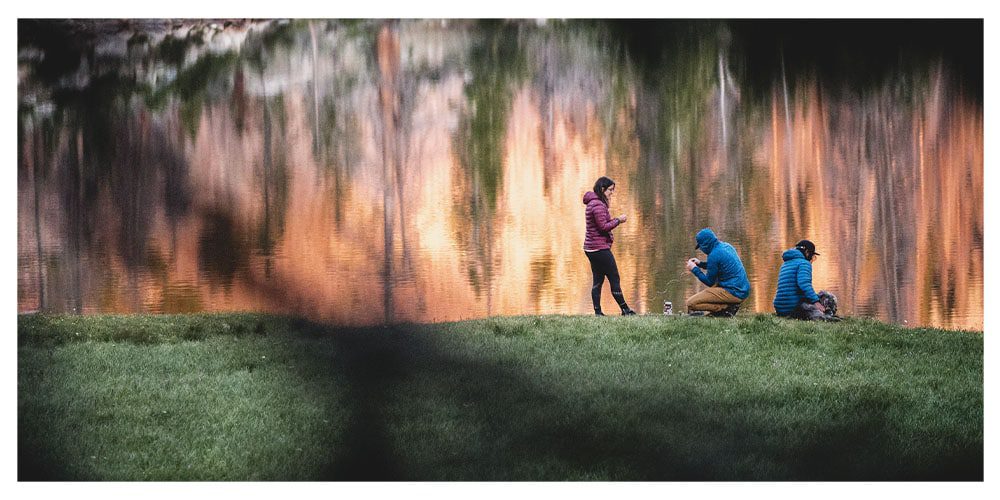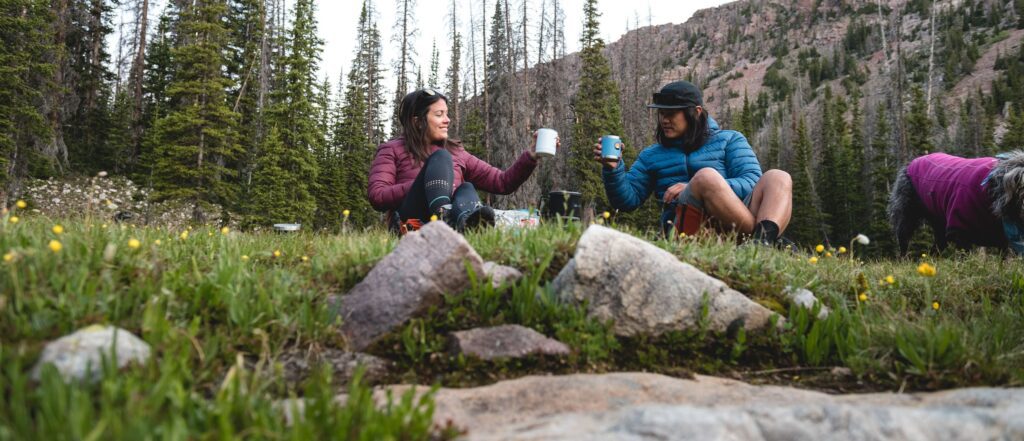How To Layer For A Backpacking TripStay Dry & Keep Warm With A Versatile Layering System
Besides looking great, what you wear backpacking is half the battle and will determine how comfortable you are on your trip. In this article, we’ll go over what you should think about when packing your clothes for backpacking, like:
- The perfect layering system
- Natural vs. synthetic materials
- Bonus: how to pack your layers for easy access in your pack
Why We Layer In The Backcountry
Carrying layers, either for a day hike or a multi-night backpacking trip, is essential for more than a few reasons. Having the proper layers allows you to regulate your own body temperature no matter what the outside temps might be in the moment–keeping you toasty in freezing conditions and stopping you from overheating on a hot summer’s day. Backpacking Trip
Why you need to layer in the backcountry:
- Comfort in changing weather conditions and temperatures
- Increased breathability and moisture wicking
While you might be tempted to bring a thicker layer rather than several thinner layers, each piece of the layering system has its own purpose, and will keep you warmer or cooler than a single article of clothing alone. Weather conditions are always subject to change, and different weather patterns call for different pieces of clothing.
Breathability is at the core of outdoor activewear. Not only do our layers need to adapt to outdoor temperatures, but they need to adjust to internal temperatures and perspiration, too. As you move through your hike, you’ll encounter several different external and internal microclimates. Layers need to be made of sweat-wicking materials that pull moisture away from the surface of your skin, keeping you warm and dry regardless of how hard you’re hiking.
Natural Versus Synthetic Materials
Most outdoor clothing falls into two camps, natural and synthetic—or a blend between the two with the different types serving different purposes.
Pros of hiking in natural layers:
- High warmth-to-weight ratio
- Insulates even when wet
- Naturally anti-microbial
- More odor-resistant
Cons of hiking in natural layers:
- higher cost
- less durable
Merino wool is favored over synthetic fabrics for its high warmth-to-weight ratio and its ability to insulate when wet. Wool is also naturally anti-microbial–making it the top contender for socks and baselayers. Backpacking Trip
Natural materials like merino wool, hemp, silk, and bamboo generally don’t hold odors as much as cotton or synthetic fibers. Unfortunately, natural materials tend to be a bit more expensive than synthetic, and may be better suited for camp wear and baselayers.

Pros of hiking in synthetic layers:
- More durable than natural fabrics
- Many different fabric options are designed for specific needs
- Lower cost
Cons of hiking in synthetic layers: Backpacking Trip
- Doesn’t retain heat as well when wet
- Holds odors
- Ultimately made of plastic, and therefore less sustainable
The more durable synthetic fabrics are ideal for activewear since these products are designed with breathability in mind. A few favored synthetic fabrics include polyester and nylon, or a blend of the two. Waffle-knit polyester shirts tend to be the most comfortable, and nylon pants are durable and breathable. Fleece is the preferred fabric for mid-layer tops since fleece will keep you warm when wet, much like wool.
It’s also important to keep ethical concerns in mind when considering which materials and brands to buy. If animal welfare is important to you, shop for sustainably harvested natural materials or shop synthetic. If you’re passionate about waste, shop recycled synthetic products like those offered by Patagonia. Backpacking Trip
And always follow the cardinal rule of hiking: don’t hike in cotton. There’s a reason the phrase, “cotton kills” exists. This applies to all cotton materials, including denim. Cotton retains moisture and takes a long time to dry, so once you sweat in cotton you’ll be soaked the remainder of your day (or night). Backpacking Trip
The Perfect Layering System For Ultimate Comfort
Whether you’re out for a day or a week you’ll want to pack a layering system so that you can handle anything Mother Nature decides to throw your way.
These are the layers you need for backpacking:
- Baselayers
- Activewear
- Mid Layer
- Outer Layer
- Outer Shell
Baselayers
Baselayers are the foundation of your layering system. This is the layer that makes direct contact with your skin, so these clothes need to be moisture-wicking, quick to dry, and breathable.
The main function of baselayers is to wick sweat away from your body, keeping you dry and warm. Moisture chills a body faster than dry air, so the secondary function of baselayers is to insulate by trapping warm air close to your skin.
Baselayers can be as minimal as a lightweight Merino wool top or as heavy as Polartec leggings, depending on the season and your preferences. Baselayers double as activewear in cold weather, keeping you warm and dry and comfortable as you hike.
Since baselayers are the primary layer, they need to be form-fitting. Not so tight that your movement is restricted–leggings and tops should always allow for a full range of motion–but baselayers need to be snug enough that loose material won’t prevent other layers from being worn over top of the others.
Activewear
You might forgo insulating baselayers in the summertime for lightweight, breathable hiking clothes like polyester blend performance shirts and shorts. Most hikers prefer to wear shorts, but don’t disregard pants and leggings–the longer material offers more protection from branches, rocks, and insects, and synthetic fabric keeps your legs warmer when it’s cold and cool when it’s hot. Backpacking Trip
Mid-Layer
The primary purpose of the mid layer is to insulate. Like baselayers, mid layers are meant to be form-fitting, though not quite as tight as baselayers. Mid layers can take the shape of long-sleeve shirts, pullovers, and jackets, as well as hiking pants for your bottom half.
Mid layers are designed to dry quickly and maintain warmth when wet. Ideally, mid layers are made with a lightweight material that packs well, so you can comfortably carry or wear your mid layers on the trail.
Outer Layer
Insulated jackets, affectionately called “puffies,” are an essential piece of gear in the backcountry, regardless of what time of year it is.
Gearheads disagree on whether down or synthetic puffies are better—it really all comes down to personal preference. Down jackets are better suited for camp—you don’t want to risk getting a down puffy wet and losing its insulation. Synthetic jackets don’t pack down as small as down puffies, but are a little more forgiving, offering some insulation even when wet.
Outer Shell
The outer shell is your body’s final protection against the elements, so investing in quality outer layers is crucial. The perfect outer shell will protect against both wind and rain, and be just large enough that your mid layer or puffy fits nicely underneath, without being too baggy.
Some winter rain jackets are also insulated, rendering a puffy unnecessary. Lightweight rain jackets paired with a puffy are better for spring, summer, and fall hiking since you have the option to use the two pieces as a system or separately. Backpacking Trip
Rain and wind pants, while often overlooked, are life-changing pieces of gear. Rain pants are designed to fit comfortably over your mid layer pants or shorts, and many styles have ankle zippers that allow you to slip on the pants without taking off your shoes. When not in use, many models pack down into their own pockets for easy portability. Backpacking Trip
While no outer layer is truly waterproof indefinitely, there are some materials that hold up a bit better than others. Look for seam-sealed jackets and pants treated with Durable Water Repellent (DWR) or a similar substance for the longest-lasting protection from the rain and wind. Backpacking Trip
Extremities
Don’t forget about your extremities when you layer up–we lose the most heat through our uncovered heads and hands than through any other part of our bodies. Bring a lightweight beanie and pair of gloves made of either fleece, polyester, or merino wool. You won’t regret it.

Packing Your Pack For Easy Access
Designate one pair of pants, a shirt, and a pair of socks just for sleeping, and keep them dry at all costs. Depending on the season, your sleeping clothes can be a pair of synthetic shorts or a set of wool long johns. Whatever you decide, pack your sleeping clothes in a dry bag to keep them clean and camp-ready. Backpacking Trip
Pack your mid layers and puffy closer to the top of your pack, within reach. You want your mid layers to be easily accessible, should you suddenly need to put on another layer. Rain jacket and rain pants can go on the outside of your pack if you have mesh or external pockets. It’s helpful to keep wet layers outside your pack, so they can dry out without soaking the rest of your gear. Backpacking Trip
Carry more layers than you think you’ll need—pack a puffy in summer and bring a rain jacket on a sunny day. It’s far better to be overprepared than underprepared. Backpacking Trip
Buying so many layers might seem like an unnecessary expense, but the right layers are essential to activities in the backcountry, whether a day hike or a thru-hike. With so many options on the market, picking out the right layers can feel overwhelming. As long as you have a moisture-wicking baselayer, an insulating mid layer, and a durable outer layer you will be more than prepared to handle any weather that comes your way. Backpacking Trip
